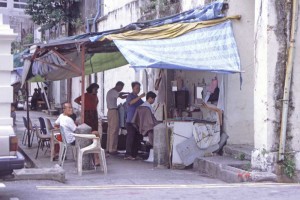By: Cher Tan
Modernization in Singapore has been exponentially rapid in the past two decades. The turn of the millennium – and thusly, the burgeoning need to live up to its reputation of being a first-world superpower – has resulted in an automatic culling of what are deemed relics of the past. The ubiquitous sidewalk cobbler that was once a fixture of the 80s and 90s have made way for boutique cobblers situated in air-conditioned shoe shops in shopping malls. The ice-cream vendor on a motorbike selling ice-cream out of his mobile freezer has all but disappeared, save for a select few situated in various parts of the CBD. Latitudes looks at some of these vanishing cultural traditions.
Mobile ice-cream vendor
These vendors operate via bicycle or motorcycles, strapped to a huge container holding various ice-cream. The makeshift freezer allows these vendors to move from one place to another easily, with cheap overheads as they would only sell medium- to low-quality ice-cream. Their arrival would usually be signalled by an 8-bit melody or the ringing of bells, and in the past would easily be situated in neighbourhood areas, especially outside schools after-hours. Of recent times however, they can only be found in tourist areas, existing only for novelty’s sake.
Street barber
Once a common sight in Singapore’s back alleys, they are now a dying breed. With only 4 street barbers believed to be the last, it appears that the trade will soon be relegated to history after 70 years. With their makeshift awnings and distinctive reclining chairs, these street barbers would do brisk business offering fuss-free trims. For some time, they also situated their mobile barbers on the corridors of HDB estates, crying out “cut hair” in various dialects. Nowadays, only a loyal customer would know exactly where these barbers are located, as their clientele are mostly made up of elderly men and migrant workers. In recent times, the price difference of $2 compared to new franchise neighbourhood salons have pushed these street barbers to make their businesses redundant.
Chinese Wayang
Wayang, a Malay word meaning “a theatrical performance employing puppets or human dancers”, commonly refers to Chinese street opera in Singapore, though it is also used in reference to other forms of opera such as wayang kulit. In Mandarin, Chinese street opera is known as jiexi (“street show”). This traditional Chinese dramatic form was brought to Singapore by immigrants from China during the 19th century as part of their religious rites. Since then, the popularity of wayang has waxed and waned, in no small part due to modern developments. Wayang is now considered an icon of Chinese heritage and culture, and is performed by both professional and amateur opera troupes, mostly during religious festivals or ceremonies, for example the Hungry Ghost Festival which occurs every year for the whole of the Lunar Chinese 7th Month (usually in August).
Karung Guni
A modern form of the “rag-and-bone” man, the karung guni man has seen its time. Visiting residences from door-to-door, the industry was made highly profitable from the 70s to the 90s due to the fact that there would be hundreds of apartment units situated in one typical public housing HDB block, with often a dozen blocks in each housing estate. These people can be distinguished by their use of horns or hand bell when making their rounds. Depending on the person, a nominal fee is paid for the quantity of newspapers or unwanted items sold. As of the 21st century, the karung guni have faced competition from government recycling initiatives and have practically been made obsolete as a result.















